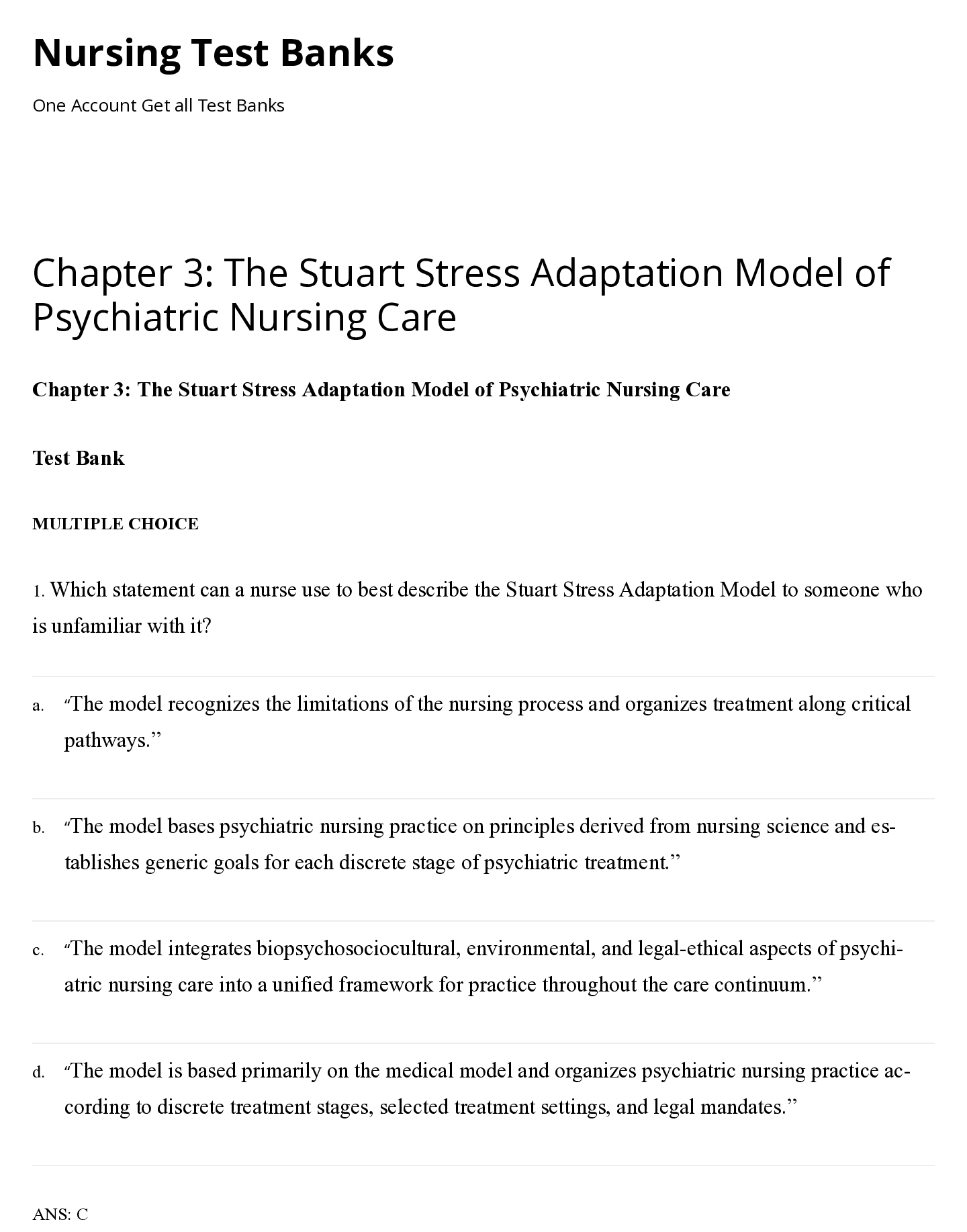*NURSING > TEST BANK > Infection Prevention and Control _ Nursing Test Banks Questions and Answers (All)
Infection Prevention and Control _ Nursing Test Banks Questions and Answers
Document Content and Description Below
Chapter 29: Infection Prevention and Control Chapter 29: Infection Prevention and Control Potter et al.: Fundamentals of Nursing, 9th Edition MULTIPLE CHOICE 1. The nurse and a new nurse in orient... ation are caring for a patient with pneumonia. Which statement by the new nurse will indicate a correct understanding of this condition? a. “An infectious disease like pneumonia may not pose a risk to others.” b. “We need to isolate the patient in a private negative-pressure room.” c. “Clinical signs and symptoms are not present in pneumonia.” d. “The patient will not be able to return home.” ANS: A Infections are infectious and/or communicable. Infectious diseases may not pose a risk for transmission to others, although they are serious for the patient. Pneumonia is not a communicable disease—a disease that is transmitted directly from one individual to the next, so there is no need for isolation. A private negative–air pressure room is used for tuberculosis, not pneumonia. Clinical signs and symptoms are present in pneumonia. Frequently, patients with pneumonia do return home unless there are extenuating circumstances. DIF:Apply (application)REF:443 OBJ: Explain the relationship between the infection chain and transmission of infection. 10/15/2016 Chapter 29: Infection Prevention and Control | Nursing Test Banks http://boostgrade.info/chapter29infectionpreventionandcontrol/ 2/33 TOP: Evaluation MSC: Safety and Infection Control 2. The patient and the nurse are discussing Rickettsia rickettsii—Rocky Mountain spotted fever. Which patient statement to the nurse indicates understanding regarding the mode of transmission for this disease? a. “When camping, I will use sunscreen.” b. “When camping, I will drink bottled water.” c. “When camping, I will wear insect repellent.” d. “When camping, I will wash my hands with hand gel.” ANS: C Rocky Mountain spotted fever is caused by bacteria transmitted by the bite of ticks. Wearing a repellent that is designed for repelling ticks, mosquitoes, and other insects can help in preventing transmission of this disease. Drinking plenty of uncontaminated water, wearing sunscreen, and using alcohol-based hand gels for cleaning hands are all important activities to participate in while camping, but they do not contribute to or prevent transmission of this disease. DIF:Apply (application)REF:444 OBJ: Explain the relationship between the infection chain and transmission of infection. TOP: Evaluation MSC: Safety and Infection Control 3. The nurse is providing an educational session for a group of preschool workers. The nurse reminds the group about the most important thing to do to prevent the spread of infection. Which information did the nurse share with the preschool workers? a. Encourage preschool children to eat a nutritious diet. b. Suggest that parents provide a multivitamin to the children. c. Clean the toys every afternoon before putting them away. d. Wash their hands between each interaction with children. 10/15/2016 Chapter 29: Infection Prevention and Control | Nursing Test Banks http://boostgrade.info/chapter29infectionpreventionandcontrol/ 3/33 ANS: D The single most important thing that individuals can do to prevent the spread of infection is to wash their hands before and after eating, going to the bathroom, changing a diaper, and wiping a nose and between touching each individual child. It is important for preschool children to have a nutritious diet; a healthy individual can ᯿贄ght infection more e᯿అectively. A health care provider, along with the parent, makes decisions about dietary supplements. Cleaning the toys can decrease the number of pathogens but is not the most important thing to do in this scenario. DIF:Understand (comprehension)REF:443 | 455 OBJ: Give an example of preventing infection for each element of the infection chain. TOP: Teaching/Learning MSC: Safety and Infection Control 4. The nurse is admitting a patient with an infectious disease process. Which question will be most appropriate for a nurse to ask about the patient’s susceptibility to this infectious process? a. “Do you have a spouse?” b. “Do you have a chronic disease?” c. “Do you have any children living in the home?” d. “Do you have any religious beliefs that will in᯿贄uence your care?” ANS: B Multiple factors in᯿贄uence a patient’s susceptibility to infection. Patients with chronic diseases such as diabetes mellitus and multiple sclerosis are also more susceptible to infection because of general debilitation and nutritional impairment. Other factors include age, nutritional status, trauma, and smoking. The other questions are part of an admission assessment process but are not pertinent to the infectious disease process. DIF:Apply (application)REF:449 OBJ: Give an example of preventing infection for each element of the infection chain. 10/15/2016 Chapter 29: Infection Prevention and Control | Nursing Test Banks http://boostgrade.info/chapter29infectionpreventionandcontrol/ 4/33 TOP: Assessment MSC: Safety and Infection Control 5. The patient experienced a surgical procedure, and Betadine was utilized as the surgical prep. Two days postoperatively, the nurse’s assessment indicates that the incision is red and has a small amount of purulent drainage. The patient reports tenderness at the incision site. The patient’s temperature is 100.5° F, and the WBC is 10,500/mm . Which action should the nurse take ᯿贄rst? a. Plan to change the surgical dressing during the shift. b. Utilize SBAR to notify the primary health care provider. c. Reevaluate the temperature and white blood cell count in 4 hours. d. Check to see what solution was used for skin preparation in surgery. ANS: B The nursing assessment indicates signs and symptoms of infection, requiring the primary health care provider to be noti᯿贄ed of the patient’s needs. SBAR—Situation, Background, Assessment, and Recommendation—can be utilized to organize thoughts and data and to provide a thorough explanation of the patient’s current status. The reevaluation of temperature is a good choice, but it will take longer than 4 hours to make a change in the white blood cells. Changing the dressing may be a need during the shift but is not a ᯿贄rst priority. Checking to see about the skin preparation used 2 days ago may or may not be useful information at this time. DIF:Analyze (analysis)REF:450 | 467 OBJ: Give an example of preventing infection for each element of the infection chain. TOP: Implementation MSC: Safety and Infection Control 6. The nurse is providing an education session to an adult community group about the e᯿అects of smoking on infection. Which information is most important for the nurse to include in the educational session? a. Smoke from tobacco products clings to your clothing and hair. b. Smoking a᯿అects the cilia lining the upper airways in the lungs. c. Smoking can a᯿అect the color of the patient’s ᯿贄ngernails. 3 10/15/2016 Chapter 29: Infection Prevention and Control | Nursing Test Banks http://boostgrade.info/chapter29infectionpreventionandcontrol/ 5/33 d. Smoking tobacco products can be very expensive. ANS: B A normal defense mechanism against infection in the respiratory tract is the cilia lining the upper airways of the lungs and normal mucus. When a patient inhales a microbe, the cilia and mucus trap the microbe and sweep them up and out to be expectorated or swallowed. Smoking may alter this defense mechanism and increase the patient’s potential for infection. Smoking can be expensive, the smell does cling to hair and clothing, and the tar within the smoke can alter the color of a patient’s nails. This information can be included in the education but does not constitute the most important point. DIF:Understand (comprehension)REF:447 OBJ:Identify the normal defenses of the body against infection. TOP: Teaching/Learning MSC: Safety and Infection Control 7. A female adult patient presents to the clinic with reports of a white discharge and itching in the vaginal area. A nurse is taking a health history. Which question is the priority? a. “When was the last time you visited your primary health care provider?” b. “Has this condition a᯿అected your eating habits in any way?” c. “What medications are you currently taking?” d. “Are you able to sleep at night?” ANS: C Antibiotics and oral contraceptives can disrupt normal ᯿贄ora in the vagina, causing an overgrowth of Candida albicans in that area. It is important to ask the patient about current medications to obtain information that may assist with diagnosis. The body contains normal ᯿贄ora (microorganisms) that live on the surface of skin, saliva, oral mucosa, gastrointestinal tract, and genitourinary tract. The normal ᯿贄ora of the vagina causes vaginal secretions to achieve a low pH, inhibiting the growth of many microorganisms. Visiting the primary health care provider is important for the patient’s health maintenance but is not the priority. Learning about the patient’s eating and sleeping habits will assist in the plan of care but is not the priority. 10/15/2016 Chapter 29: Infection Prevention and Control | Nursing Test Banks http://boostgrade.info/chapter29infectionpreventionandcontrol/ 6/33 DIF:Analyze (analysis)REF:447 | 452 OBJ:Identify the normal defenses of the body against infection. TOP: Assessment MSC: Safety and Infection Control 8. The nurse is caring for a school-aged child who has injured the right leg after a bicycle accident. Which signs and symptoms will the nurse assess for to determine if the child is experiencing a localized in᯿贄ammatory response? a. Malaise, anorexia, enlarged lymph nodes, and increased white blood cells b. Chest pain, shortness of breath, and nausea and vomiting c. Dizziness and disorientation to time, date, and place d. Edema, redness, tenderness, and loss of function ANS: D The body’s cellular response to an injury is seen as in᯿贄ammation. Signs of localized in᯿贄ammation include swelling, redness, heat, pain or tenderness, and loss of function in the a᯿అected body part. Systemic signs of in᯿贄ammation include fever, malaise, and anorexia, as well as enlarged lymph nodes and increased white blood cells. Chest pain, shortness of breath, and nausea and vomiting are signs and symptoms of a cardiac alteration. Dizziness and disorientation to time, date, and place may indicate a neurologic alteration. DIF:Apply (application)REF:446 OBJ: Discuss the events in the in᯿贄ammatory response. TOP: Assessment MSC: Safety and Infection Control 9. Which interventions utilized by the nurse will indicate the ability to recognize a localized in᯿贄ammatory response? a. Vigorous range-of-motion exercises b. Turn, cough, and deep breathe 10/15/2016 Chapter 29: Infection Prevention and Control | Nursing Test Banks http://boostgrade.info/chapter29infectionpreventionandcontrol/ 7/33 c. Orient to date, time, and place d. Rest, ice, and elevation ANS: D Signs of localized in᯿贄ammation include swelling, redness, heat, pain or tenderness, and loss of function in the a᯿అected body part. One sign of the in᯿贄ammatory response, particularly after an injury, is swelling or edema. Resting the a᯿అected injured area, using ice as ordered, wrapping the area to provide support—particularly if it is an extremity—and elevating the injured area will help to decrease swelling or edema. Turning, coughing, and deep breathing are utilized for postoperative patients and for immobilized patients to help prevent an infectious process such as pneumonia. Orientation to date, time, and place is an intervention utilized with many di᯿అerent types of patients who may be confused. Vigorous range of motion would irritate the in᯿贄ammatory process. Range of motion is utilized for individuals who need to improve movement of their extremities, including immobilized patients. DIF:Analyze (analysis)REF:446 OBJ: Discuss the events in the in᯿贄ammatory response. TOP: Implementation MSC: Basic Care and Comfort 10. The nurse is caring for a group of medical-surgical patients. Which patient is most at risk for developing an infection? a. A patient who is in observation for chest pain b. A patient who has been admitted with dehydration c. A patient who is recovering from a right total hip surgery d. A patient who has been admitted for stabilization of heart problems ANS: C The patient who is recovering from a right total hip surgery has a large incision from the surgery. This break in the skin increases the likelihood of infection. Any break in the integrity of the skin and mucous membranes 10/15/2016 Chapter 29: Infection Prevention and Control | Nursing Test Banks http://boostgrade.info/chapter29infectionpreventionandcontrol/ 8/33 allows pathogens to enter and exit the body. The patient has had anesthesia, which depresses the respiratory system and has the potential to decrease the expansion of alveoli and to increase the chance of infection in the respiratory system. A patient who is having chest pain, experiencing dehydration, or being admitted with heart problems does not have open incisions that break the skin; therefore, his or her infection risk is lower. DIF:Analyze (analysis)REF:444-445 | 447 OBJ: Identify patients most at risk for infection. TOP: Assessment MSC: Safety and Infection Control 11. The nurse is caring for a patient with leukemia and is preparing to provide ᯿贄uids through a vascular access (IV) device. Which nursing intervention is a priority in this procedure? a. Review the procedure with the patient. b. Position the patient comfortably. c. Maintain surgical aseptic technique. d. Gather available supplies. ANS: C You maintain surgical aseptic technique at the patient’s bedside (e.g., when inserting IV or urinary catheters, suctioning the tracheobronchial airway, and sterile dressing changes) because patients with disease processes of the immune system are at particular risk for infection. These diseases include leukemia, AIDS, lymphoma, and aplastic anemia. These disease processes weaken the defenses against an infectious organism. Reviewing the procedure with the patient, positioning the patient, and gathering the supplies are all important steps in the procedure but are not the priority in the procedure since the patient already has a compromised immune response. DIF:Apply (application)REF:449 | 467 OBJ: Identify patients most at risk for infection. TOP: Implementation MSC: Safety and Infection Control 12. The nurse is caring for an adult patient in the clinic who has been evacuated and is a victim of ᯿贄ooding. The nurse teaches the patient about rest, exercise, and eating properly and how to utilize deep breathing and 10/15/2016 Chapter 29: Infection Prevention and Control | Nursing Test Banks http://boostgrade.info/chapter29infectionpreventionandcontrol/ 9/33 visualization. What is the primary rationale for the nurse’s actions related to the teaching? a. Topics taught are standard information taught during health care visits. b. The patient requested this information to teach the extended family members. c. Stress for long periods of time can lead to exhaustion and decreased resistance to infection. d. These techniques will help the patient manage the pain and loss of personal belongings. ANS: C The body responds to emotional or physical stress by the general adaptation syndrome. If stress extends for long periods of time, this can lead to exhaustion, whereby energy stores are depleted and the body has no defenses against invading organisms. Techniques of deep breathing and visualization may be helpful with pain, but they are not the primary reason. The teachings listed are not all standard interventions taught at every health care visit. There is no data to indicate the patient requested this information for the family. DIF:Analyze (analysis)REF:449 OBJ: Identify patients most at risk for infection. TOP: Planning MSC: Safety and Infection Control 13. The nurse is caring for a patient who is susceptible to infection. Which instruction will the nurse include in an educational session to decrease the risk of infection? a. Teaching the patient about fall prevention b. Teaching the patient to take a temperature c. Teaching the patient to select nutritious foods d. Teaching the patient about the e᯿అects of alcohol ANS: C [Show More]
Last updated: 2 years ago
Preview 1 out of 33 pages
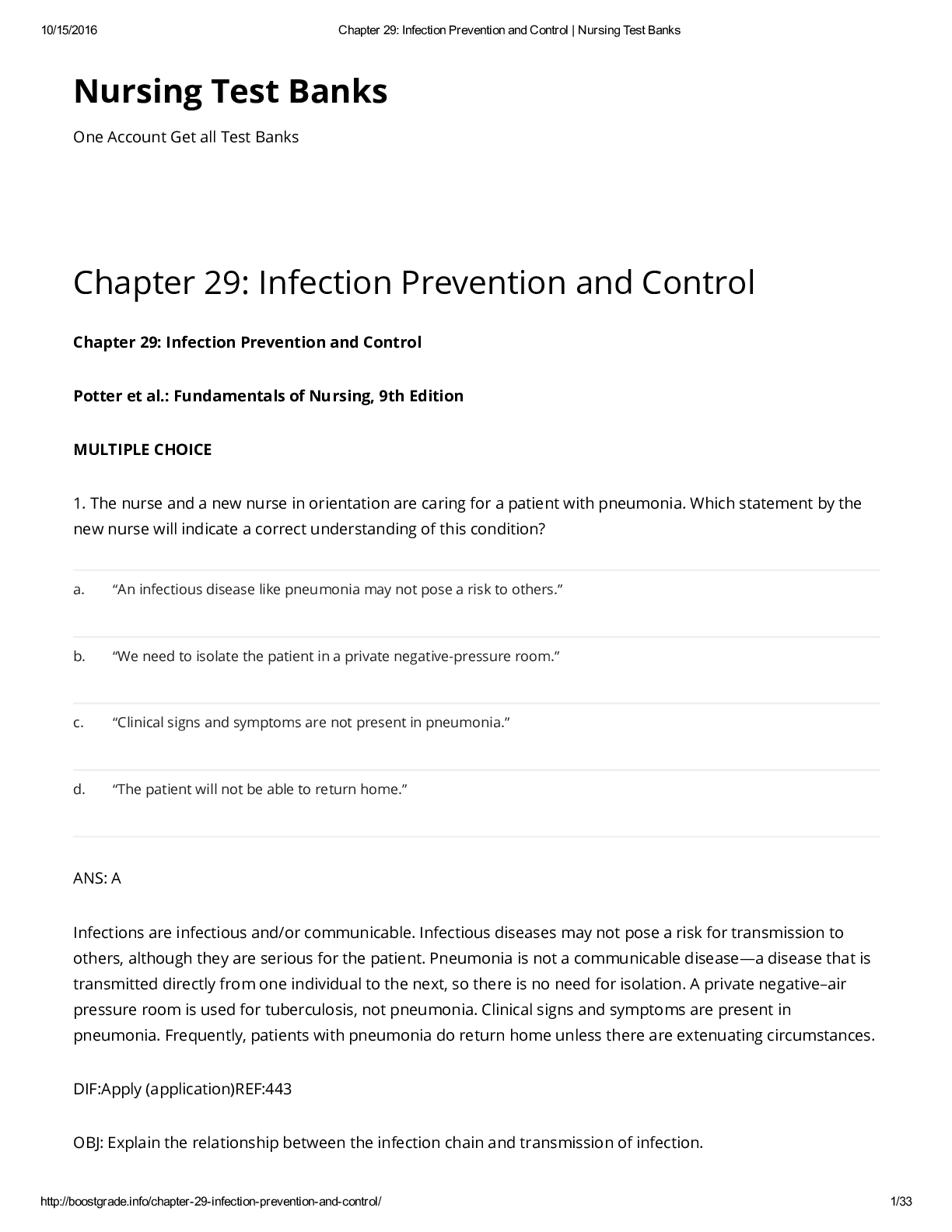
Buy this document to get the full access instantly
Instant Download Access after purchase
Buy NowInstant download
We Accept:

Reviews( 0 )
$12.00
Can't find what you want? Try our AI powered Search
Document information
Connected school, study & course
About the document
Uploaded On
Aug 27, 2021
Number of pages
33
Written in
Additional information
This document has been written for:
Uploaded
Aug 27, 2021
Downloads
0
Views
153


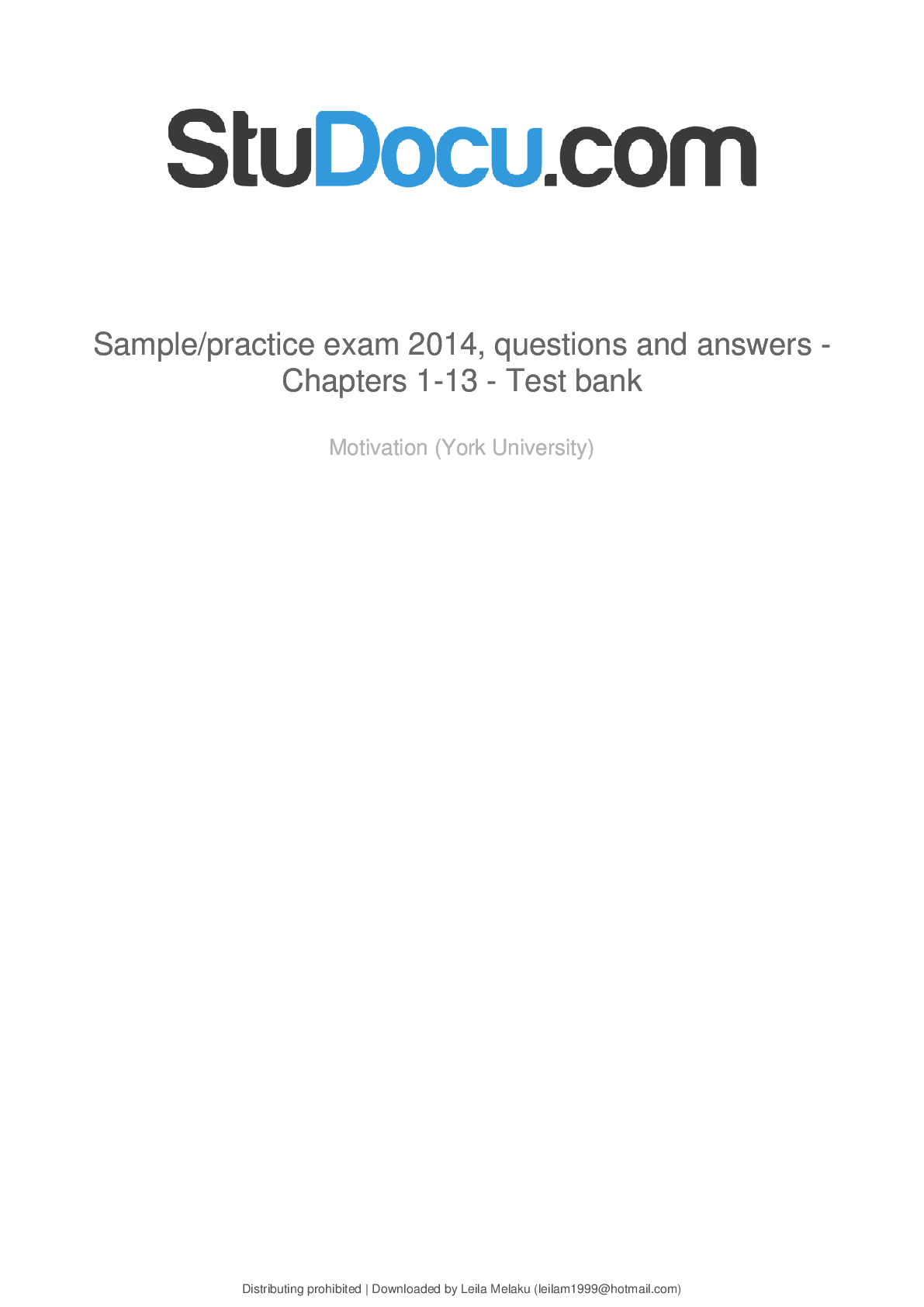
.png)

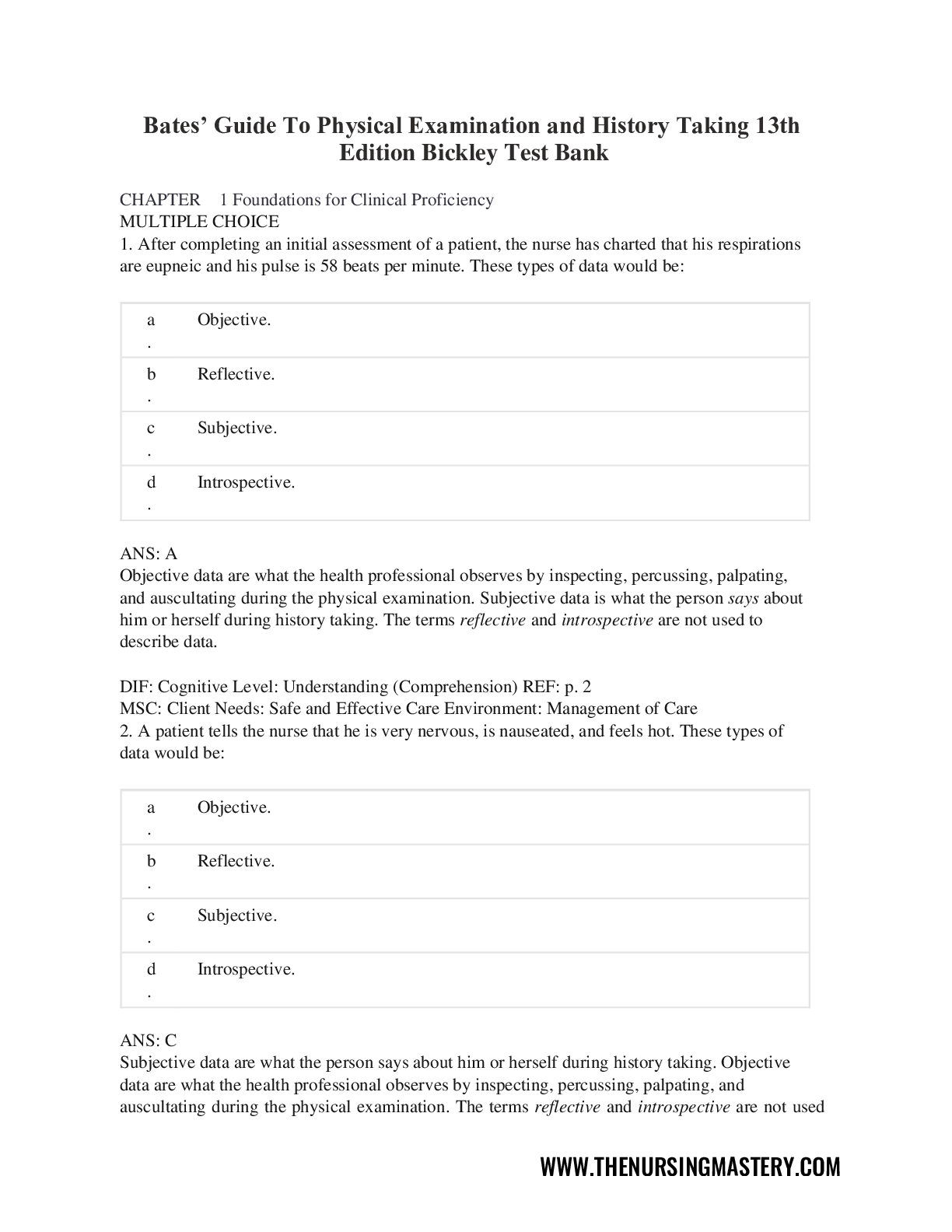
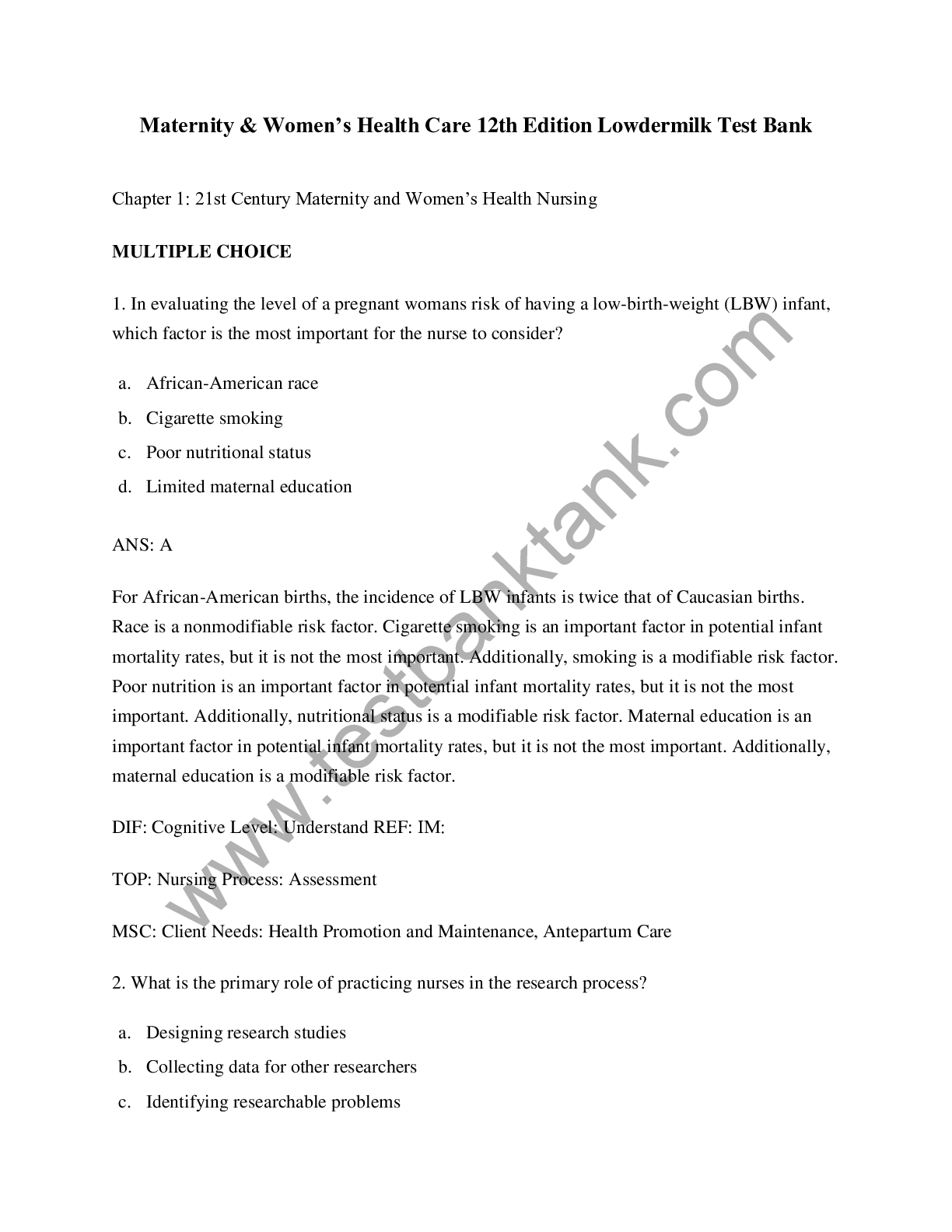
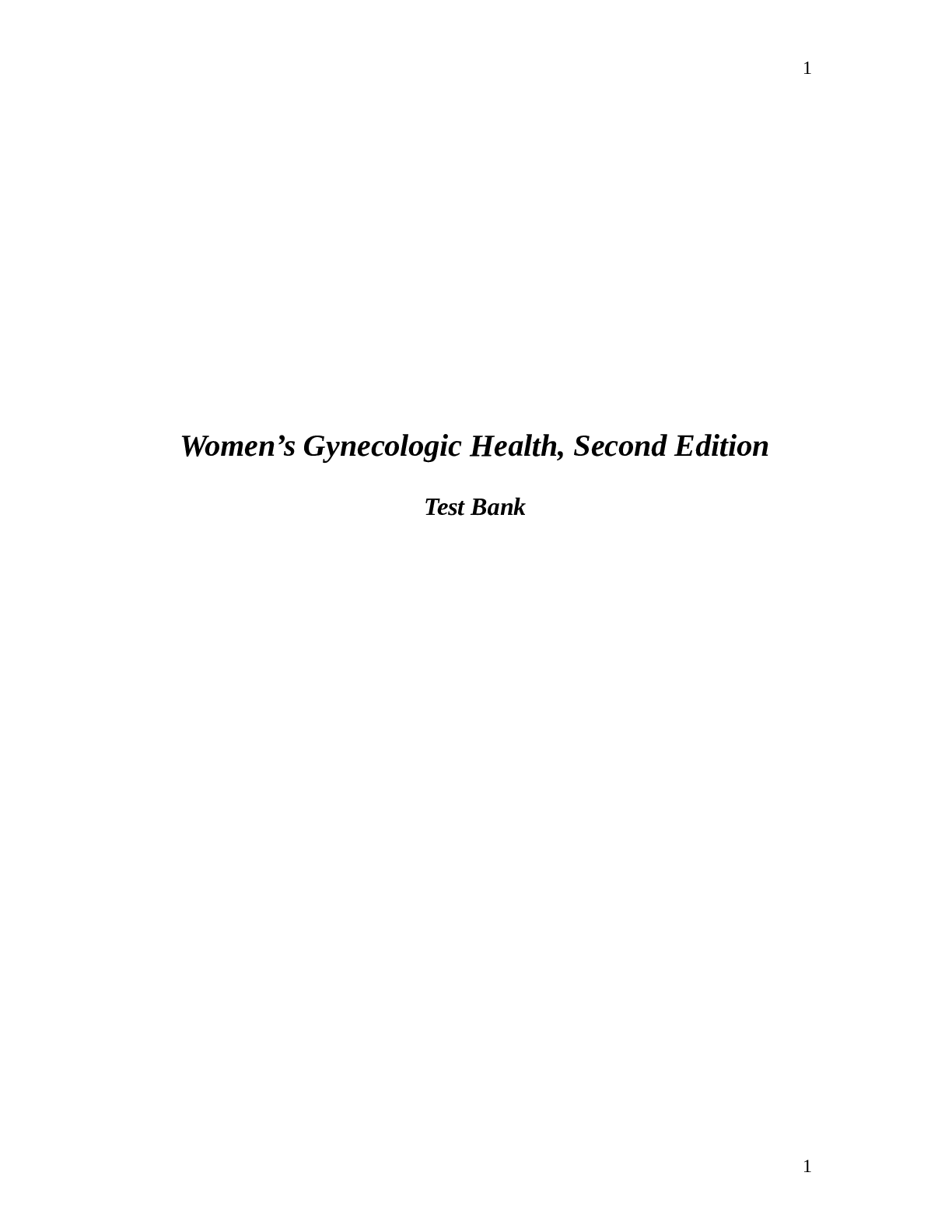


.png)
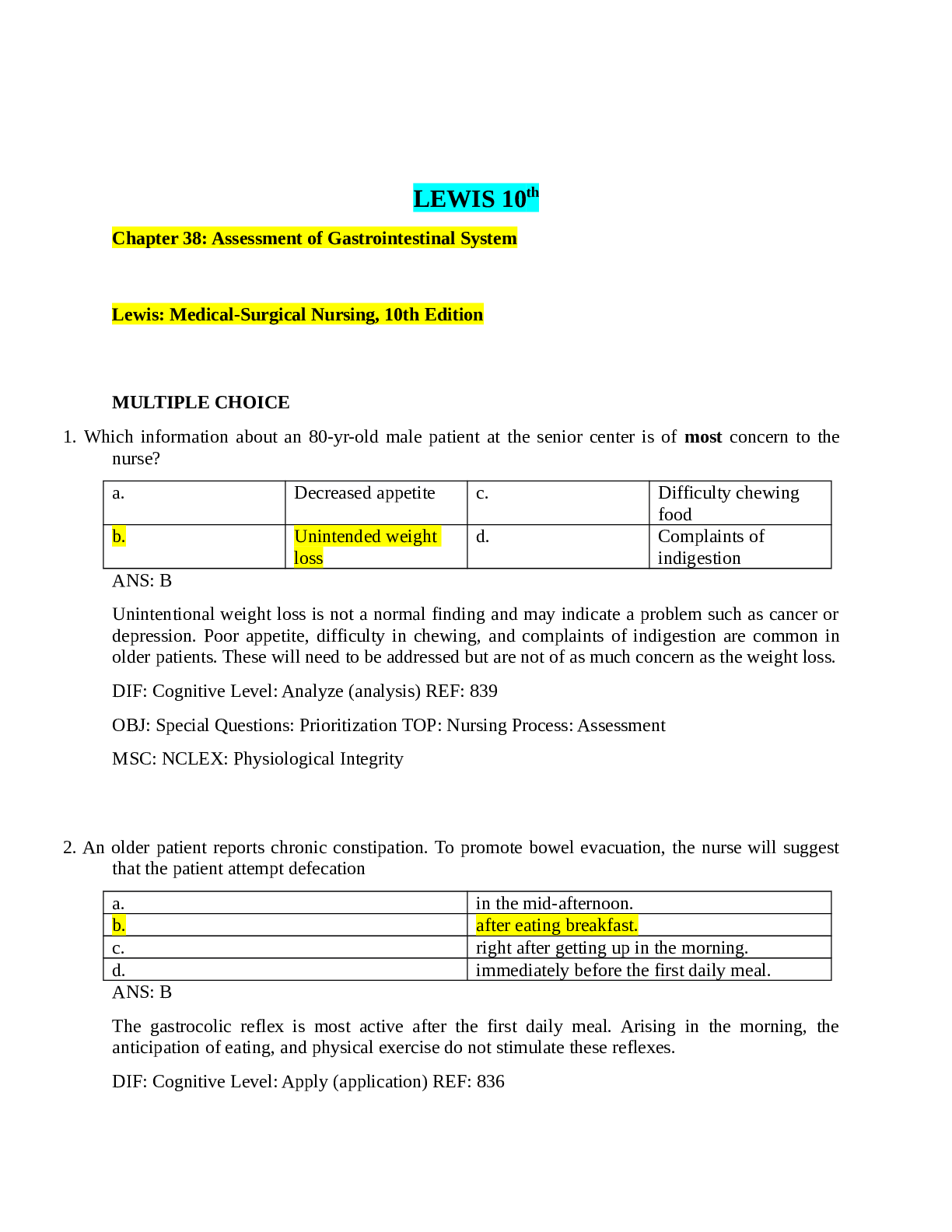
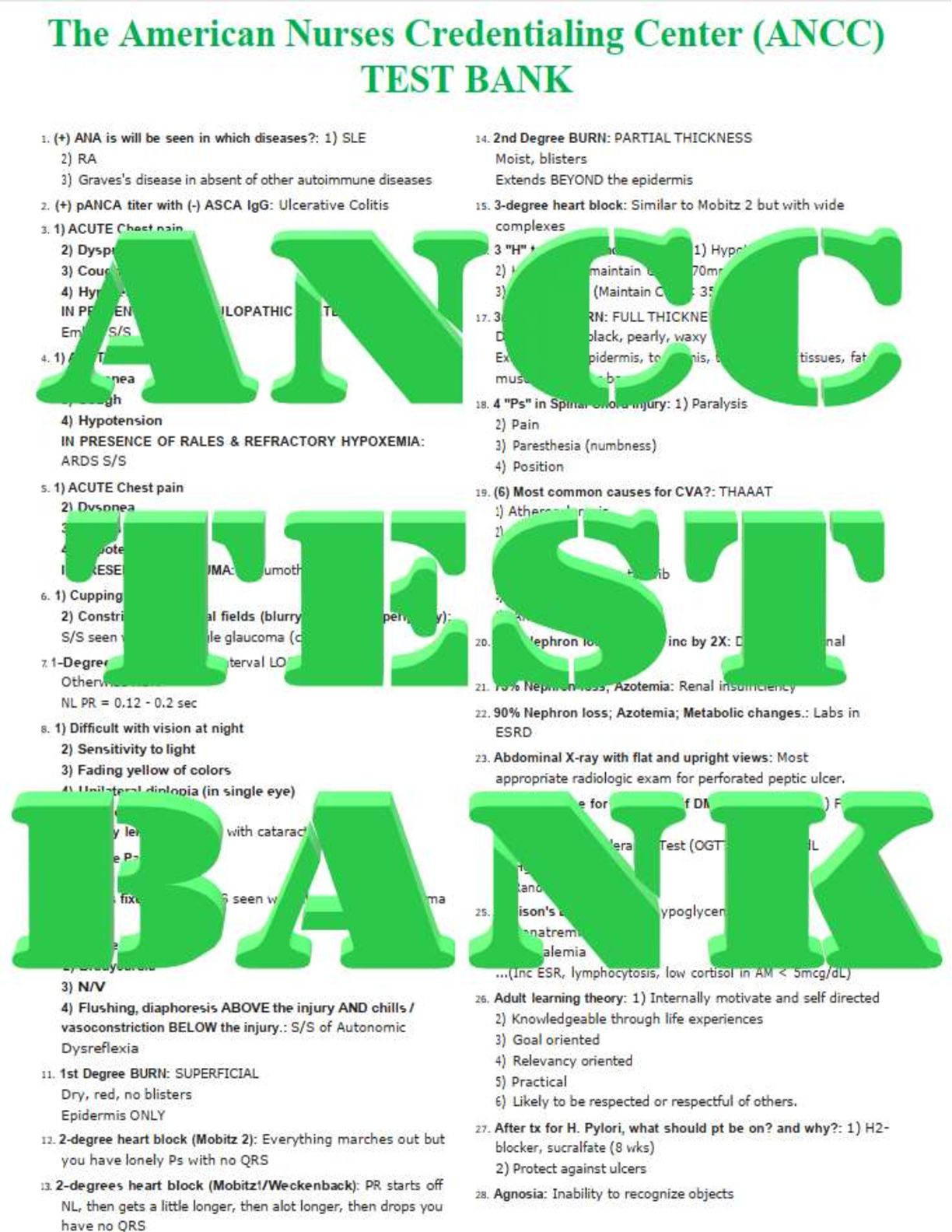
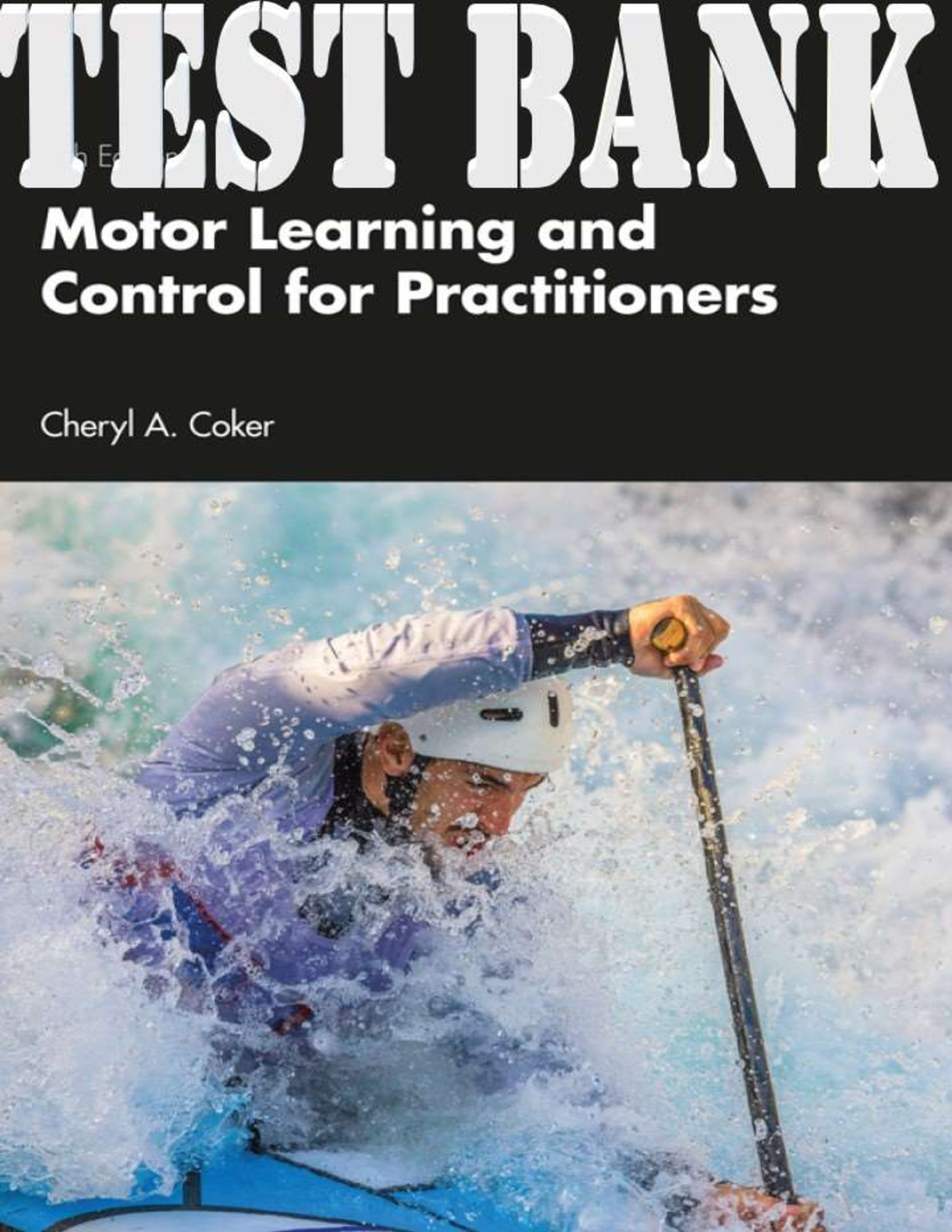

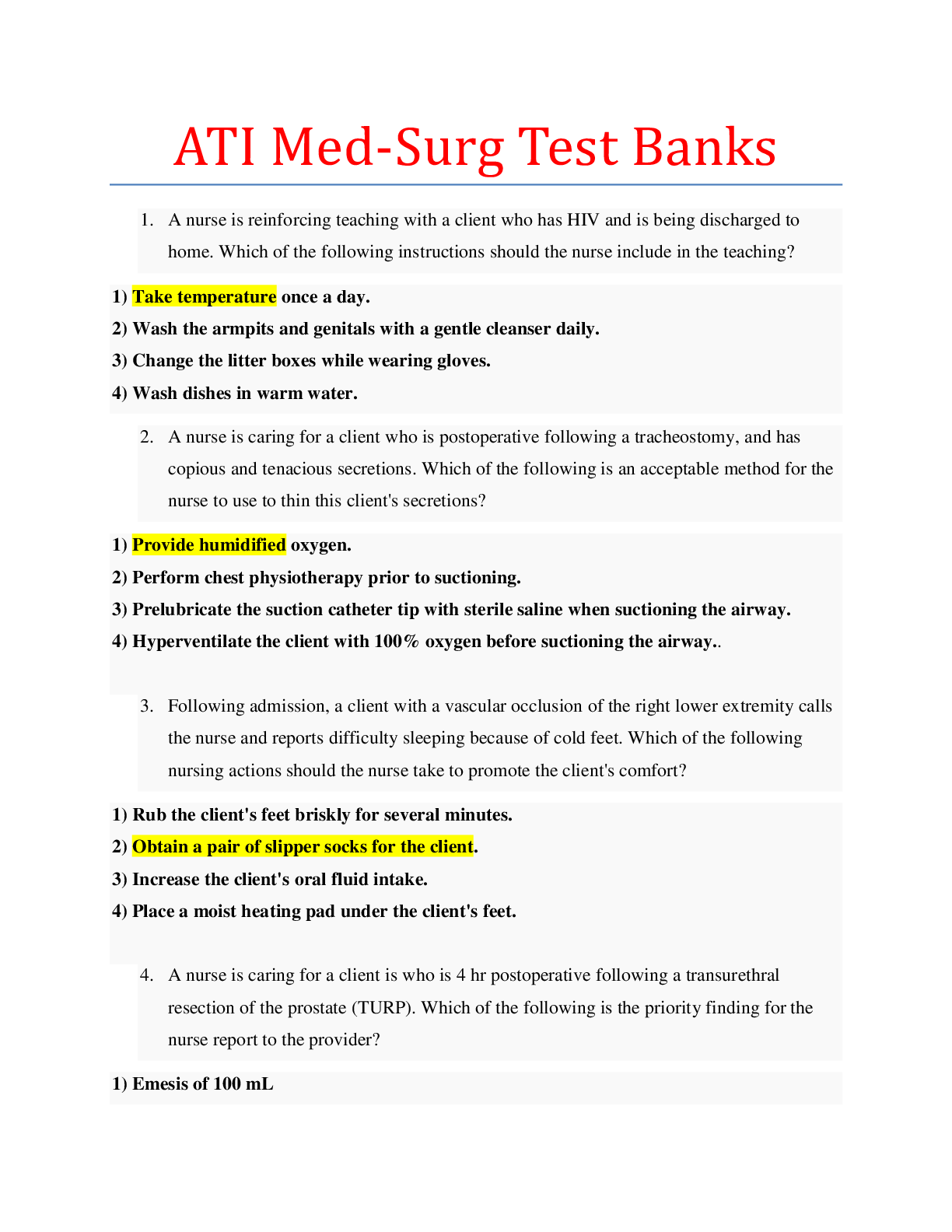
.png)




